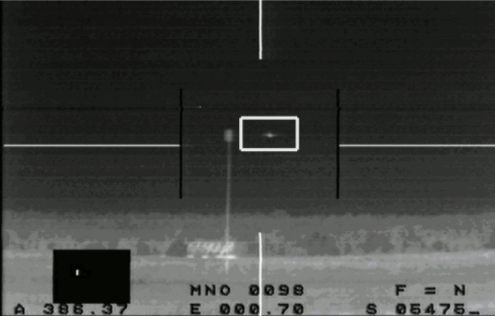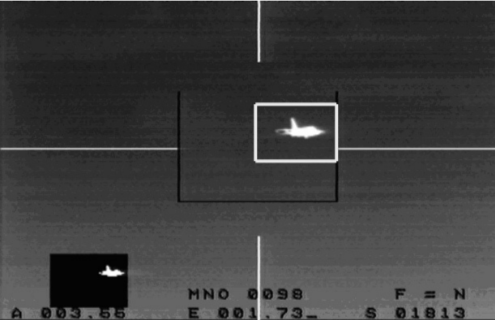Passive ranging using image intensity and contrast measurements
Zarko P. Barbaric, Boban P. Bondzulic, Srdjan T. Mitrovic
Abstract
Proposed are two passive ranging approaches using a single camera, based on intensity and contrast measurements. According to the Beer-Lambert law and known atmosphere extinction coefficient and initial range, the range to a moving object is estimated. Using these approaches in a real infrared surveillance sequence, better results are obtained than with methods which use image size measurements. The relative error of 3.2% for contrast and 2.3% for intensity features are obtained. Results indicate that range estimation is possible to a fidelity required for object tracking.1 Introduction
Passive ranging is of special interest for wide range of applications, such as video surveillance and security, air traffic control, speed control, obstacle detection, homing missile guidance, weapon fire control, etc. The most common techniques used to passively estimate range to an object employ optical flow or/and triangulation [1]. The methods given in [2, 3], exploit size changes of an object in the video sequence, as inferred by processing video frames, to compute distance. As we know, thermal image size measurement is difficult, since the edge of object is not clear [4]. The measurement of object size depends on image processing for object extraction. Furthermore, systems relying on triangulation require two or more sensors [1].
Two passive ranging methods using intensity and contrast measurements from one sensor are suggested in this paper. No prior knowledge about the sensor or about the size, shape or any other features of the object is assumed. Suggested methods allow accurate distance estimation even where multiple sensor views or active measurements are not possible.
2 Theory
The intensity or grey level in the image is a function of scene radiance attenuated by transmission through the atmosphere, and characteristics of the image sensor. In its simplest form this relationship becomes:The image contrast is given by:
Passive range estimations from (4) and (5) are based on measurements of intensity and contrast. To resolve them we need reliable estimates of extinction coefficient and initial range . Extinction coefficient may be estimated on the base of optical visibility at 0.55μm by programs such as LOWTRAN, MODTRAN, or using known algorithms [5]. Initial range to the object can be measured by a laser rangefinder and/or by other passive ranging methods.
3 Experiment
Theoretical passive ranging methods are tested on infrared image sequence for an airborne object. The sequence is generated by SkyTrack system, which is used for a tracking of air targets. This system uses two cameras for distance measurement. In this paper we use infrared image sequence from one of the cameras with distance given by the system for each frame. Figure 1. shows the first and the last frames of the sequence, with bounding boxes around the aircraft.

Detection and segmentation from Fig. 2. are done by Tsai's method [6] providing object region . Mean value of object grey level and object contrast on Fig. 2. are calculated from the object in . Range estimation given in Fig. 2, , is calculated using three different approaches: proposed intensity (4) and contrast (5) methods and using image size as in [3]:
4 Analysis of results
Fig. 3 shows estimated target distances obtained using the proposed contrast and intensity methods as well as the area based method. Estimates provided by the proposed methods quickly stabilise close to the ground truth provided by the SkyTrack system for the first 300 frames. In the last 50 frames however sensor intensity saturation as the object moves closer to it causes divergence of the estimates and the true distance. Additionally, significant background changes during these frames influence the contrast measure.From Fig. 3 it is obvious that distance estimation by image size significantly differs from true distance, over almost the whole sequence. At the end of the sequence its difference from the true distance has decreased to less than that of the proposed methods.
Using the proposed methods we obtain the relative error of 2.3% for intensity and 3.2% for contrast approaches, for the relevant (i.e. non-saturated) 300 frames.
5 Conclusion
We propose intensity and contrast methods for passive ranging using a single camera. Results indicate that proposed approaches are suitable for object tracking, because they provide relative ranging error of less than 3.5%, for large distances. Results obtained and analysed in this paper suggest the use of a hybrid approach with image size, intensity and contrast features all taken into account. Future work will include more complex object motion profiles and incorporating a Kalman tracker.References
- Barniv Y. Error analysis of combined optical-flow and stereo passive ranging, IEEE Transactions on Aerospace and Electronic Systems, 1992, 28(4), pp. 978-989
- Rao R. and Lee S. 'A video processing approach for distance estimation', Proc. IEEE Int. Conf. on Acoustics, Speech and Signal Processing, Toulouse, France, July 2006, Vol. III, pp. 1192-1195
- Raju, C., Zabuawala, S., Krishna, S. and Yadegar, J. 'A hybrid system for information fusion with application to passive ranging', Proc. of Int. Conf. on Image Processing, Computer Vision and Pattern Recognition, Las Vegas, June 2007, pp. 402-406
- Diao, W.-H., Mao, X., Chang, L. and Jiang, L.: 'Operating distance evaluation method for infrared imaging system under complicated backgrounds', Electronics Letters, 2009, 45(25), pp. 1309-1310
- Dikic, G.D. and Djurovic, Z.M.: 'Unbiased estimation of atmosphere attenuation coefficient', Electrical Engineering, 2007, 89, pp. 343-347
- Tsai W.-H 'Moment-preserving thresolding: A new approach',Computer Vision, Graphics, and Image Processing, 1985, 29(3), pp. 377-393
- Downey GA. 'Electro-optical tracking considerations II', Proc. of SPIE: Acquisition, Tracking, and Pointing XVII, 5082, Orlando, April 2003, pp. 139-153, doi:10.1117/12.487943